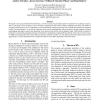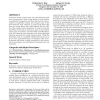206 search results - page 3 / 42 » Predicting Effectiveness of Automatic Testing Tools |
TPDS
2002
13 years 10 months ago
2002
One of the most fundamental problems automatic parallelization tools are confronted with is to find an optimal domain decomposition for a given application. For regular domain prob...
KBSE
2006
IEEE
14 years 4 months ago
2006
IEEE
Software systems often undergo many revisions during their lifetime as new features are added, bugs repaired, abstractions simplified and refactored, and performance improved. Wh...
LREC
2010
14 years 9 days ago
2010
We present LIPS (Lexical Isolation Point Software), a tool for accurate lexical isolation point (IP) prediction in recordings of speech. The IP is the point in time in which a wor...
C3S2E
2008
ACM
14 years 26 days ago
2008
ACM
In the last decade, a great many code clone detection tools have been proposed. Such a large number of tools calls for a quantitative comparison, and there have been several attem...
ICSM
2008
IEEE
14 years 5 months ago
2008
IEEE
Aspect-oriented programming (AOP) is gaining popularity with the wider adoption of languages such as AspectJ. During AspectJ software evolution, when regression tests fail, it may...


